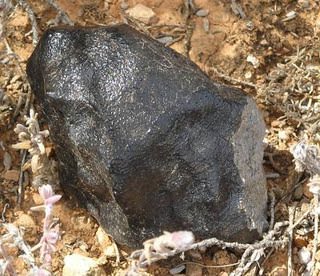A network of time-lapse cameras set up in the Nullarbor Plain desert of Western Australia has allowed researchers to track a fallen meteorite to the ground, and enabled them to determine its original orbit and parent body. The meteorite has a composition different than that of other meteors, leading researchers to believe that it originates from a different parent body than most meteorites that impact Earth. The Desert Fireball Network, a project coordinated by the Imperial College of London, was able to track the meteor when it entered the atmosphere, giving researchers an impact location and information on where it originated.
The Bunburra Rockhole meteorite – so named for the location where it was discovered – fell to the Earth on July 20th, 2007. The Desert Fireball Network cameras recorded the fireball produced when the meteor passed through the Earth’s atmosphere, and by studying the entry angle of the meteor, researchers from the Imperial College were able to locate it on the ground. It was found within 100 meters (300 feet) of where they had predicted it to be.
This meteorite weighs 324 grams (12 oz), and is composed of a rare type of basalt igneous rock. More specific information on the meteorite itself can be found on the Meteorological Society’s index. Most meteorites of this composition come from one parent body, the asteroid 4 Vesta. However, the Bunburra Rockhole meteorite likely came from a different asteroid with a different orbit, which means that the formation process for the asteroid happened in a different place in the Solar System than for 4 Vesta.
The researchers determined that the Bunburra Rockhole originated from an asteroid located in the innermost main asteroid belt between Mars and Jupiter. Because the Desert Fireball Network captured images on multiple cameras of how it entered the Earth’s atmosphere, the researchers were able to triangulate the position of the rock, and model its orbit backwards in time to determine its origins.

Dr Gretchen Benedix of the Natural History Museum – where the largest fragment of the meteorite is located – analyzed the mineral content of the meteorite. She said in a press release:
“It’s vital to have a meteorite with information about where it comes from in the solar system…. We’ve known for a long time that most meteorites are from the asteroid belt, but we don’t know exactly where. This kind of information helps us fit one more piece in the puzzle of how the solar system formed and evolved. The fact that this meteorite is compositionally unusual increases it’s value even more. It helps us to uncover more information about the conditions of the early solar system.”
The Desert Fireball Network monitors the Nullarbor desert in Western Australia, and has tracked a total of 7 meteorites, three of which have been recovered. The desert is an excellent location for this type of project, as observing conditions are clear many nights out of the year, and the sparse vegetation and monotone landscape make finding the meteorites easier than in other locations.
The results of the meteorite mineral and orbital study are published in Science, and two previous papers about the Bunburra Rockhole are available on the Desert Fireball Network site.


This project seems to work quite efficiently, and what a location, the meteorite fertile Nullarbor Plain in Australia. Maybe a similar efficient network could be set up on Mars, someday.